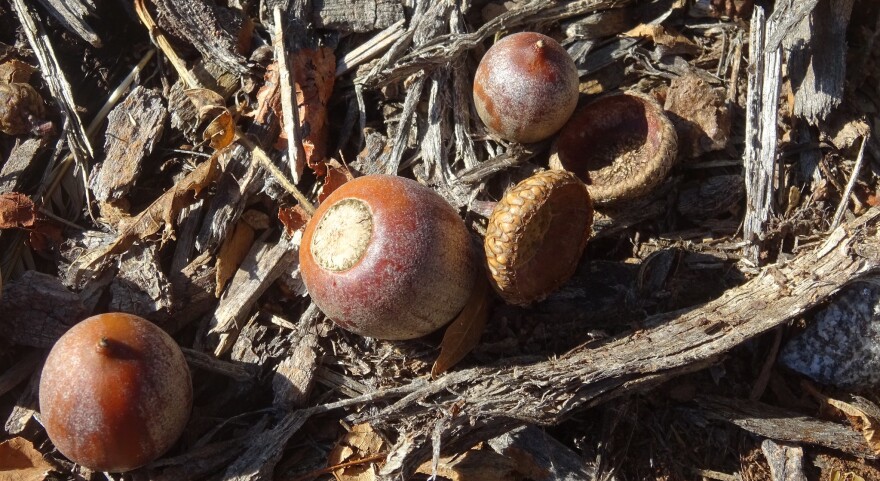If you’ve been on a walk lately, you may notice the sidewalks are a bit more crunchy than usual, with a lot more acorns on the ground this year.
Texas oak trees are experiencing something called a mast year, meaning trees are dropping extra fruit this season.
Courtney Blevins, an urban forester with the Texas A&M Forest Service, spoke with the Standard about the phenomenon and how it affects the ecosystem.
Texas Standard: What is a mast year? I don’t think I’ve ever heard that expression before. And what does it mean?
Courtney Blevins: Well, it seems fairly common here in Texas. About every two to five years, it’s thought, oak trees will put out a really huge bumper crop of acorns. And the exact reason or trigger for it is not known.
You know, weather can have a lot to do with flower production or aborting flowers in the spring, and if that happens, you can have less acorns, for instance. The exact reason is not known, but the result’s pretty clear.
And they think it does benefit the tree in that these mast years really put out so many acorns that all the predators — the squirrels and all the animals that deer that eat those acorns — cannot consume them all. So, there are some left over to regenerate the trees’ population. And that’s kind of the ecological benefit of the thing.
So what kind of trees do we typically see this phenomenon in?
Well, we’ve got a lot of different oak species in Texas. It can be any of them. The most common you’re going to see probably in Central Texas and up my way in the Dallas-Fort Worth area is going to be Shumard red oak, Texas red oak, live oak.
Now, there’s plenty of others, but those are the ones most often people buy at a nursery and plant in their yard. So they’re most likely going to see the acorn production on those top species.
Well, you mentioned that it’s not clear why we get them in this sort of periodicity, if I’m using that word correctly — we don’t know why they happen some years rather than others. Any ideas, though, about what causes this? Perhaps might it be linked to the drought we saw this year?
Well, that’s the most common thought. But, you know, there are some people that think, "okay, when oak trees get really stressed, they put on a bumper crop of acorns just kind of in case they die." You know, it’s a last-ditch effort to reproduce.
But for that to be true, the drought wouldn’t make for excess acorn production. You know, the acorns produced in the fall depend on the flowers in the spring, which occurred before the drought. And even if it was drought, you’d think that would make flowers abort and so we’d have less acorns.
So, you know, again, we don’t know the exact reason. It seems a little hard for me to wrap my head around it, that the drought could cause an increase in acorns — unless you believe that it’s the tree’s last ditch effort to save itself with some young seeds.
What ways does this benefit the tree? I guess this would be very resource intensive to put out as much fruit, like you’re saying there, and then drop it all at once.
Yeah, it does definitely take up a lot of energy of the tree. But the idea or the thought is that in these years where they make so many acorns that, like I said before, the predators — the squirrels, the deer, the foxes, the things that eat acorns — cannot consume such a large crop and therefore there are extra left over, which can then germinate and sprout and turn into new trees. That’s just one theory behind it.
You talk about some of those critters — the squirrels that eat some of these nuts. And I wonder if there are ripple effects as a result of having a lot of very well-fed animals out there.
Yeah, there probably, definitely is. And one of the other things that the flipside of the heavy mast years is that the in-between years, it’s much, much less acorns produced. And so the populations of these predators — the squirrels, again, it’s hard to think of them as a predator, but for acorns they0 are thought to maybe decrease some.
So then when you do have the big year again, there’s less of them. So you’ve got the two-pronged attack there: sort of reduced number of predators and massive increase in acorns, which hopefully leave some extra to turn into new trees.
Copyright 2023 KUT News. To see more, visit KUT News.

